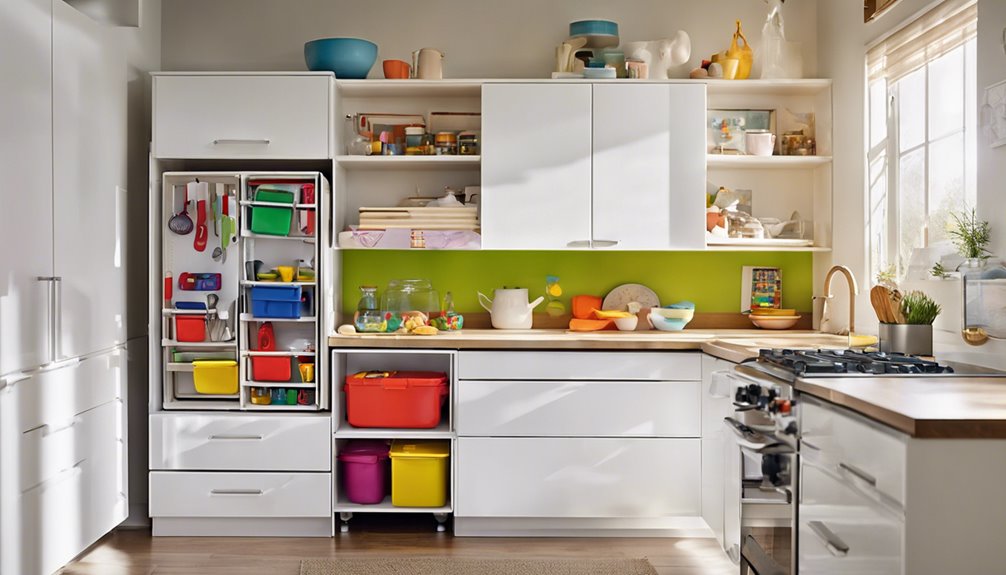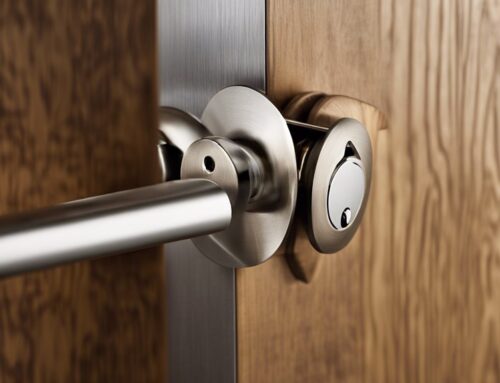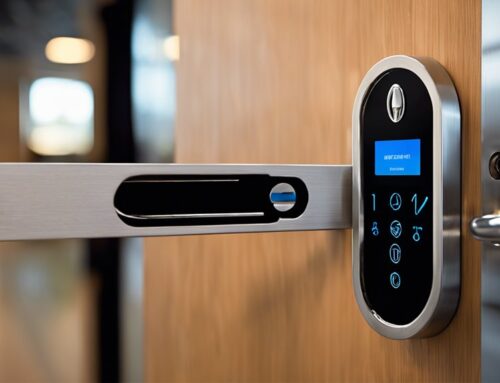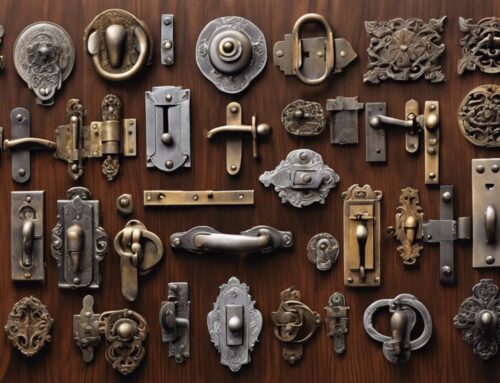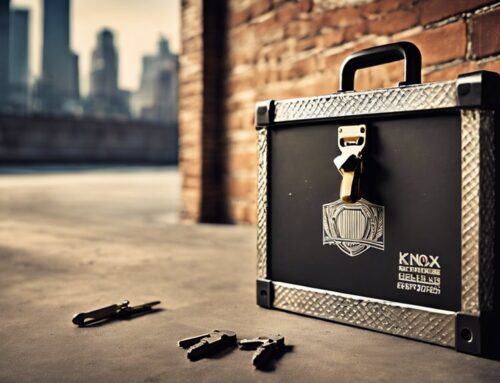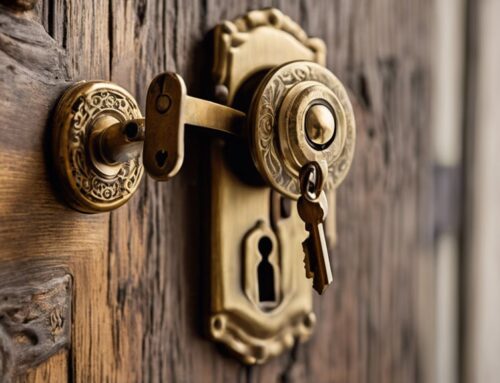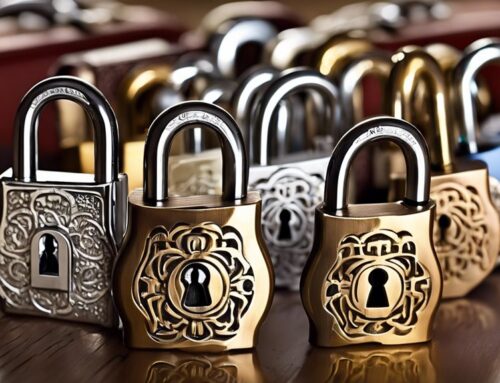Child safety locks are essential for ensuring your home is secure from hazards. Different types, like magnetic, adhesive strap, and spring action locks, cater to various furniture and door needs. These locks prevent children from accessing dangerous items, enhancing overall safety and providing peace of mind. Installation is straightforward, but double-check alignment and follow manufacturer guidelines to avoid common mistakes. Regular maintenance, including inspections and cleaning, keeps them functioning well. By choosing appropriate locks and considering your child’s age, you can create a safer space. Curious about the best locks for your home? Keep exploring to discover more insights!
Key Takeaways
- Child safety locks come in various types, including magnetic, adhesive strap, spring action, cord and slide locks, and door knob covers, each serving specific needs.
- These locks prevent harmful access, reduce the risk of accidents, and enhance overall home safety by securing dangerous areas and restricting exits.
- Installation tips include gathering necessary tools, cleaning surfaces, measuring accurately, and regularly maintaining locks to ensure long-term effectiveness.
- Common mistakes to avoid include incorrect installation techniques, inadequate measurement, ignoring manufacturer guidelines, and choosing the wrong type of lock for your needs.
- Prioritize products that meet safety standards, ensuring durability, reliability, and compliance to create a secure environment for children.
Types of Child Safety Locks
When it comes to securing your home for little ones, understanding the different types of child safety locks can make all the difference.
Magnetic locks, for instance, boast significant magnetic advantages. These locks remain hidden and can only be released with a magnetic key, creating a sleek, unblemished decor while guaranteeing hazardous items stay out of reach. They work best on cabinets without handles, offering a seamless look without visible hardware. User feedback indicates that these locks hold up well against persistent toddlers, ensuring reliable long-term use.
On the other hand, adhesive strap locks provide remarkable adhesive flexibility. These locks are easy to install with their adhesive backing, allowing for quick attachment to cabinets or drawers. The flexible straps latch securely around corners, and you can remove them when not in use, making them perfect for family dynamics that change with visits from grandparents.
Additionally, spring action locks offer a straightforward approach with no keys needed. Though they require some pre-drilling, they effectively safeguard your spaces.
Finally, cord and slide locks are an excellent choice for temporary setups, locking side-by-side cabinets without the need for drilling or adhesives.
Choose the type that best suits your needs to guarantee your little ones stay safe and your home stays stylish.
Benefits of Child Safety Locks
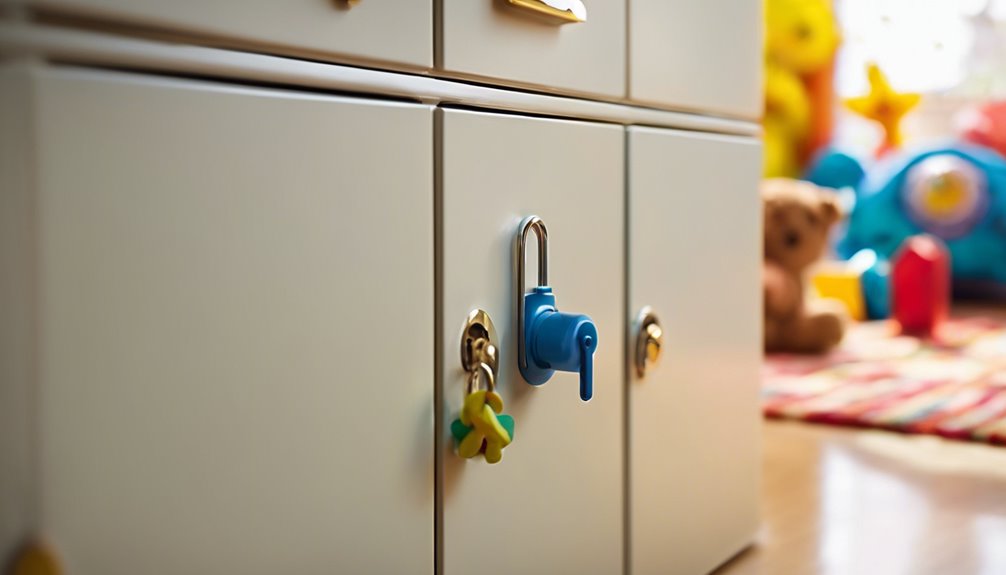
When you use child safety locks, you’re actively preventing your little ones from accessing harmful items and areas in your home.
These locks not only protect children from potential hazards like sharp objects and cleaning supplies but also improve overall safety by creating a more secure environment. Additionally, electromagnetic cabinet locking devices utilize magnets to provide hidden locks that enhance both safety and aesthetic appeal.
Prevent Harmful Access
Installing child safety locks is crucial for preventing access to harmful items in your home. With these locks in place, you create a barrier that keeps children away from medications, cleaning products, and chemicals that could lead to poisoning or serious injuries. By securing cabinets and drawers, you empower yourself to enforce child safety, greatly reducing the risk of accidents.
Furthermore, child safety locks on electrical outlets and switches protect against electrical shocks, while locks on sharp objects keep your little ones safe from cuts and injuries. It’s not just about preventing access; it’s about taking control of your environment to guarantee accident prevention.
Additionally, these locks help keep children from unsupervised access to potentially dangerous areas, such as kitchens, garages, or outdoor spaces. With safety measures like these, you considerably lower the chance of incidents, guaranteeing your home remains a safe haven.
In an age where the unexpected can happen in seconds, installing child safety locks is a proactive step for any vigilant parent. You’re not just safeguarding your child; you’re also fostering peace of mind for yourself.
Enhance Overall Safety
While nobody wants to think about the dangers that lurk in their own home, child safety locks greatly enhance overall safety by creating effective barriers against potential hazards.
These locks improve home security by securing both exterior and interior doors, preventing unauthorized exits and restricting access to areas that require child supervision. Utilizing door knob covers or lever handle locks means you can keep doors securely closed, ensuring children can’t wander off unnoticed.
Window safety measures, such as restrictors and locks, further bolster your home’s safety profile. These devices limit how far windows can open and block access without keys, reducing the risk of falls and accidents.
Installing pool fencing locks is equally essential in ensuring that children remain safe from unsupervised access to potentially dangerous areas.
Beyond physical protection, child safety locks offer significant psychological benefits. They provide you with peace of mind, allowing you to focus on other parenting aspects without the constant worry of potential dangers.
Embracing these security measures empowers you to manage daily life with less stress, knowing your child is safeguarded from potential risks in your home.
Installation Tips for Locks
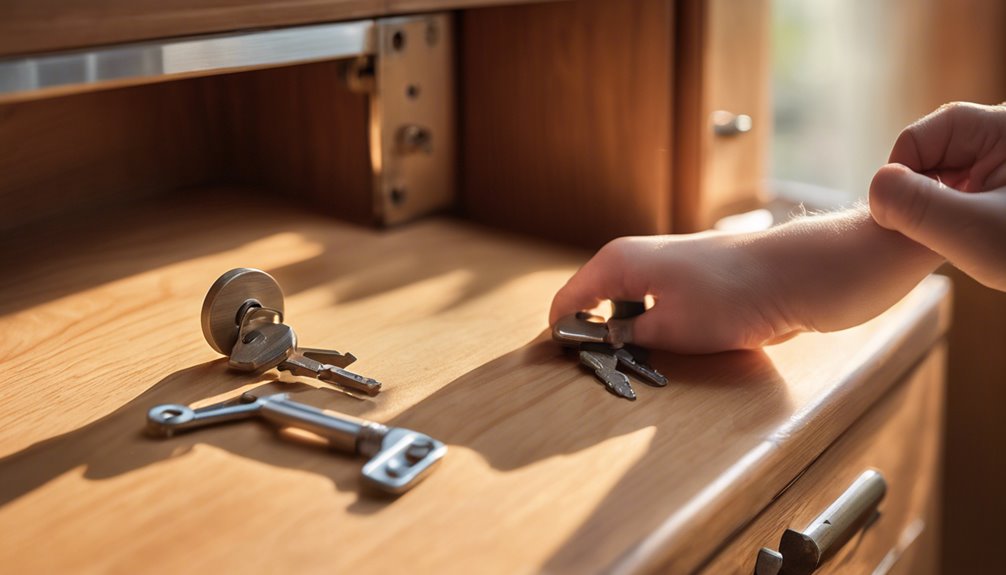
To guarantee a successful installation of child safety locks, proper preparation and careful application are key. Begin by gathering your installation tools, ensuring they align with the type of lock materials you’re working with. Follow these essential steps:
- Clean the Area: Wipe down the surfaces where your locks will be placed, ensuring ideal adhesion or drilling.
- Measure Accurately: Measure the depth of the drawer or cabinet front to position the lock correctly. Use an installation template if available.
- Position and Align: Place the lock and catch accordingly, applying firm pressure to bond the adhesive or secure the screws.
Once positioned, give the adhesive sufficient time to set – ideally 24 hours – before testing the lock’s effectiveness.
Regular maintenance is vital; routinely check that all locks operate smoothly and meet safety standards.
Common Mistakes to Avoid
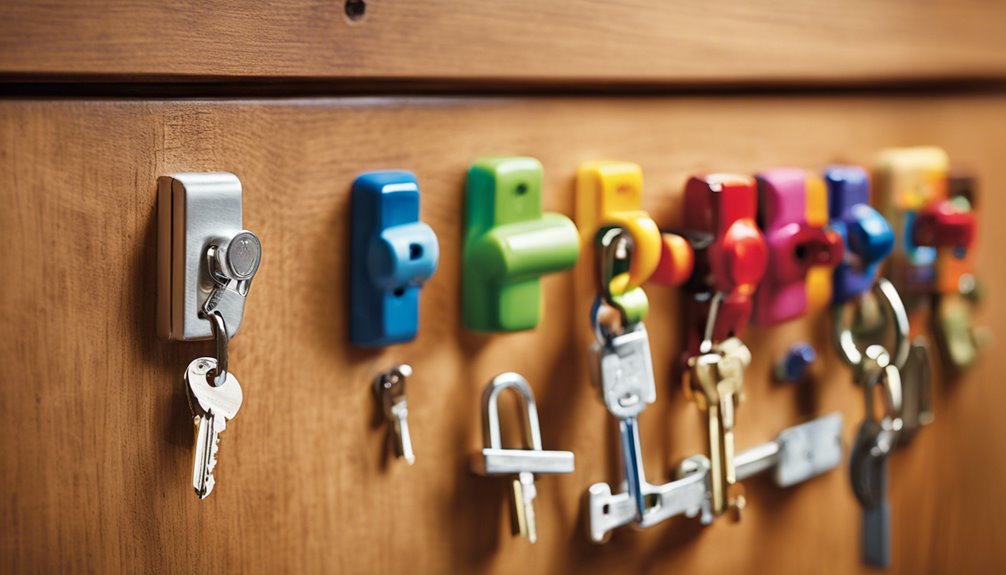
When securing your home with child safety locks, it’s essential to avoid common pitfalls.
You might unintentionally install locks in the wrong locations, select inadequate products, or fail to maintain consistent usage.
Incorrect Installation Techniques
Incorrect installation techniques can lead to significant safety hazards when setting up child safety locks. To guarantee effective and secure installation, avoid these common mistakes:
1. Inadequate Measurement: Failing to accurately measure door and lock dimensions can create installation challenges, resulting in instability. Always guarantee that the distance between the door lock mounting holes is precise.
2. Ignoring Manufacturer Guidelines: Not following the manufacturer’s installation instructions can compromise lock positioning and overall effectiveness.
Using the wrong tools can further exacerbate installation challenges and lead to damage.
3. Ineffective Installation Methods: Installing locks using adhesive mounts can cause damage when removed.
Instead, opt for durable materials and secure mechanisms to prevent easy bypass by children.
Wrong Lock Selection
Selecting the wrong locks can create significant safety risks in your home, especially when it comes to keeping children safe. To guarantee you’re making an informed decision, consider lock compatibility issues and conduct a thorough security feature evaluation.
Here’s a quick overview of common mistakes to avoid:
| Lock Type | Common Mistakes |
|---|---|
| Magnetic locks | Not suitable for door handles |
| Strap-like locks | Ineffective for cabinets without handles |
| Basic locks | Can be easy for older toddlers to open |
| Adhesive mounts | May fail in high-risk areas |
Always align the lock design with the type of door handle you’re using. Additionally, consider the age and capability of your child. For younger kids, magnetic locks work well, but older children might bypass them. Verify that the locks meet safety standards and can endure tampering. Avoid non-compliant locks, as they can jeopardize your family’s safety. Investing in high-quality locks tailored to specific needs is essential for effective child safety measures.
Inconsistent Usage Practices
Inconsistent usage practices can undermine the effectiveness of child safety locks, putting your little ones at risk. To enhance safety, you must develop structured habits and improve caregiver communication.
Here are some common mistakes to avoid:
- Frequent Disengagement: If you constantly disengage locks for convenience, you may forget to re-engage them, increasing the risk of accidents.
- Inconsistent Use: Make certain that all necessary areas—kitchen, cabinets, and bathrooms—are consistently secured. Inconsistent practices can create hazardous gaps, exposing your child to potential dangers.
- Overlooking Specific Needs: Assess the unique safety needs of different rooms. Not all locks fit every scenario, so customize your approach for maximum protection.
Regularly evaluate and maintain your safety locks, making sure they function correctly.
Don’t neglect feedback from your child’s other caregivers; their insights can reveal unnoticed vulnerabilities.
Safety Regulations and Standards
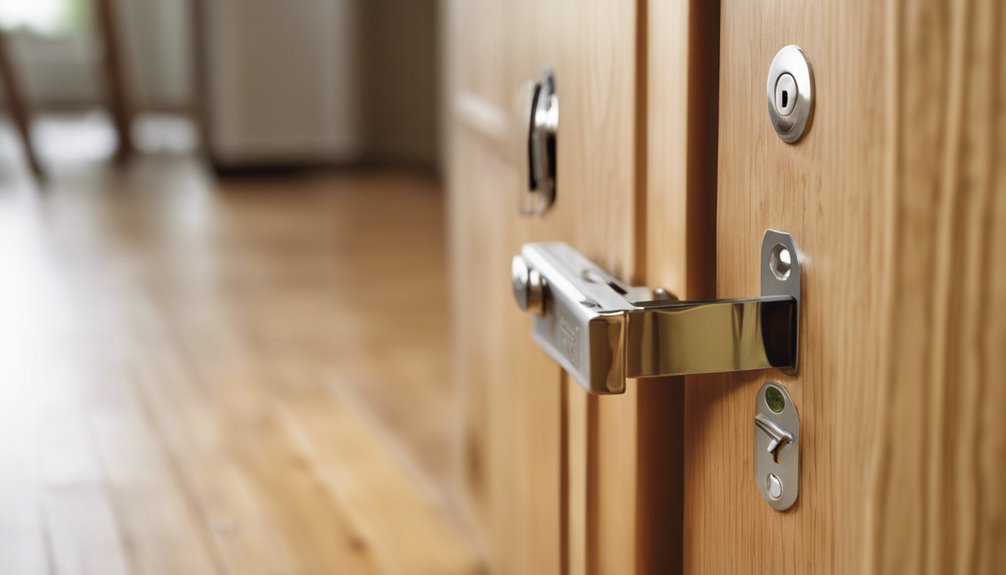
Safety regulations and standards play an essential role in guaranteeing child safety locks effectively protect young children from accessing potentially dangerous areas at home and in vehicles. The ASTM Standard F3492-21 outlines the necessary safety requirements, including an average breaking strength of 45.3 lbs or greater. Compliance with these safety standards is mandatory for manufacturers, making certain that locks installed on cabinet doors and drawers prevent children under 48 months from accessing harmful contents.
Since 1970, U.S. law has required child safety locks for containers holding dangerous medicines and household cleaning products, enforced by the Consumer Products Safety Commission. This regulatory compliance helps safeguard children from accidents and injuries.
The effectiveness of child safety locks in your home relies on adherence to these standards, as they dictate testing procedures and installation practices. Be sure to select locks compliant with applicable regulations, such as the Federal Motor Vehicle Safety Standard No. 206 for automotive applications.
Regular checks and maintenance are vital to guarantee each lock remains functional and effective. By prioritizing regulatory compliance and understanding safety standards, you enhance the level of protection your child has in various environments.
Additional Safety Measures
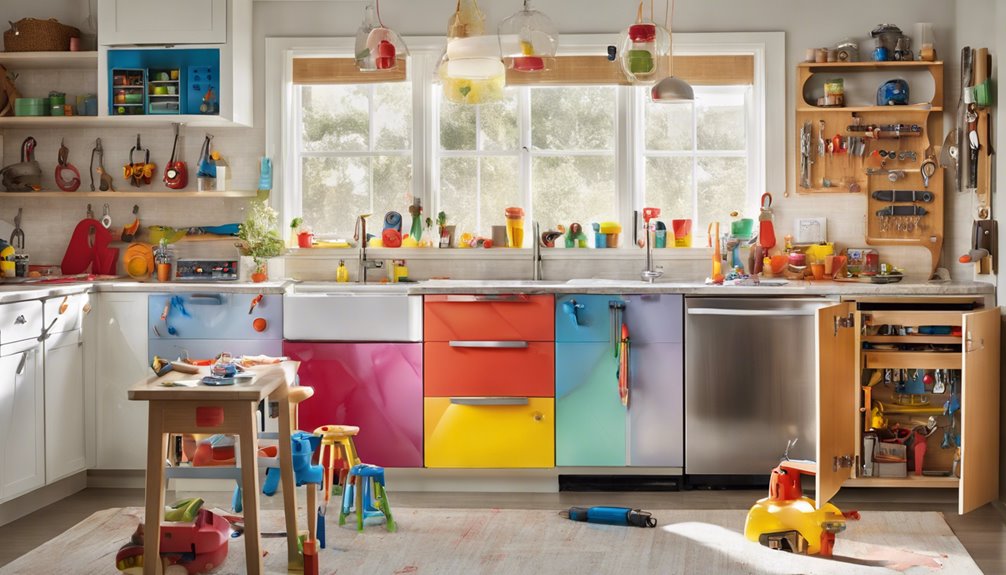
While adhering to safety regulations and standards for child safety locks is essential, it’s equally important to implement additional measures to create an all-encompassing childproof environment.
These proactive steps not only safeguard your children but also enhance your emergency preparedness.
- Supervise: Always keep a watchful eye during playtime, especially near water, heights, and potential hazards.
- Teach Safety Rules: Equip your children with safety education tailored to their age. Inform them about road safety, stranger danger, and safe play zones.
- Regularly Inspect: Perform routine checks on child safety devices and surroundings. Look for tripping hazards and verify furniture is anchored properly.
Choosing the Right Lock
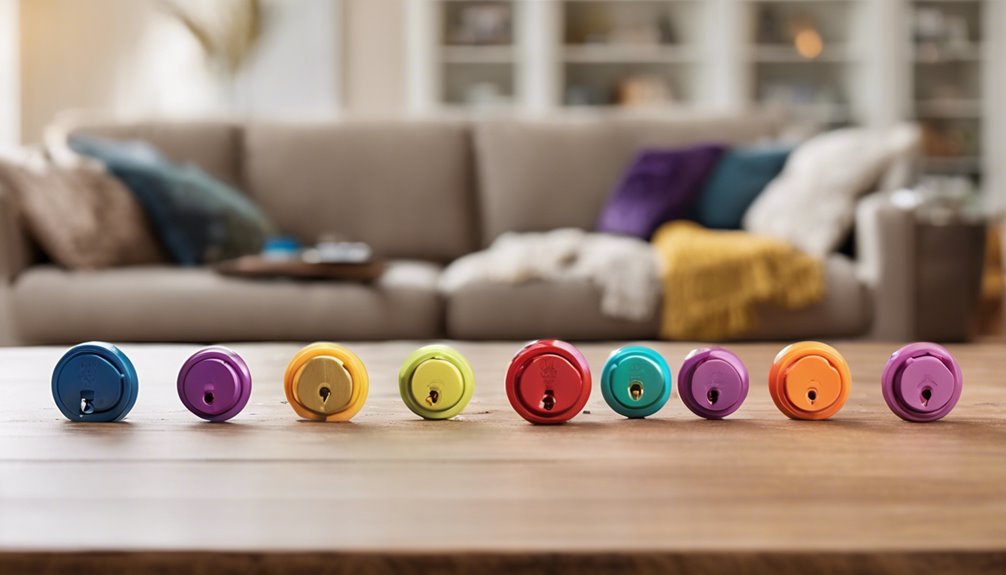
When it comes to childproofing your home, selecting the right locks can make a significant difference in keeping your little ones safe. Start by identifying the specific areas that need securing—cabinets, drawers, or doors. Each lock type serves a unique purpose; for instance, cabinet locks are essential for safeguarding hazardous items in the kitchen, while window locks help prevent accidental falls.
As you choose, pay attention to lock material options and lock design features. Durability is critical, so opt for locks that are made from robust materials that withstand frequent use. Hidden magnetic locks are ideal for cabinets without handles, while strap locks provide versatile and adjustable solutions for various locations.
Ease of installation should also be a priority. Look for options with adhesive backing or simple screw-on installation. Aesthetics matter too; select locks that blend seamlessly with your decor while offering functionality.
Confirm that the locks you choose meet safety standards, permitting easy adult access but effectively keeping children away. By evaluating these factors, you’ll empower yourself to create a safer home environment for your kids.
Maintenance and Inspection
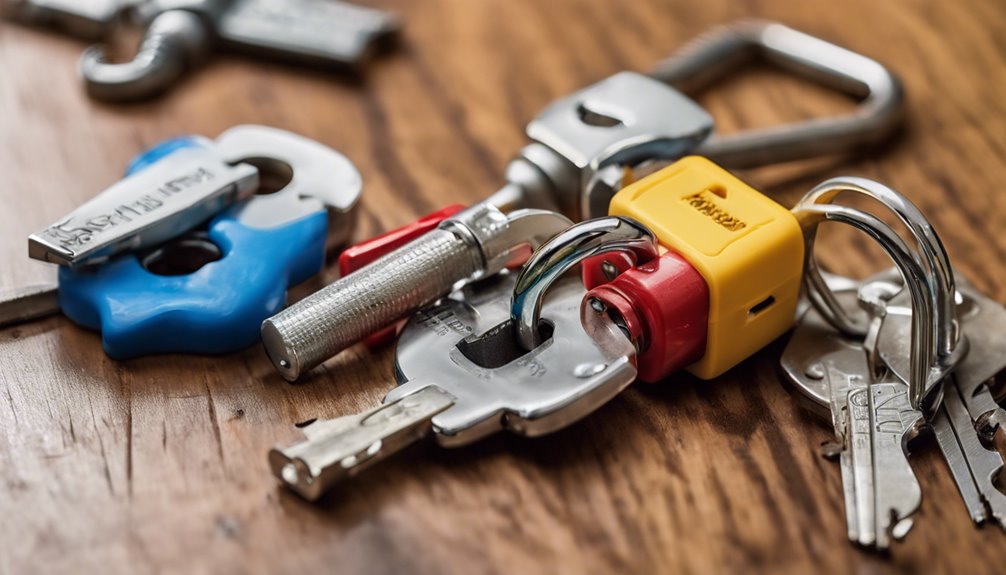
Regular maintenance and inspection of child safety locks are essential to confirm they function effectively and provide the protection your kids need.
Implement a proactive maintenance schedule to preserve lock functionality. Here’s how to maintain and inspect your locks effectively:
- Regular Cleaning: Use a damp cloth with mild detergent to clean all lock surfaces. For magnetic and spring-action locks, verify there’s no debris obstructing their functions.
- Inspect for Wear and Tear: Regularly check sliding door locks and other mechanisms. Test by opening, closing, or applying pressure. Look for any signs of misalignment or peeling adhesives.
- Functional Testing: Simulate normal use; engage and disengage locks multiple times to confirm smooth operation. Pay particular attention to any visible damage like cracks or rust, which may compromise safety.
If you identify issues, don’t hesitate to replace them immediately.
Opt for high-quality replacements and follow installation instructions for secure fittings. Regular lubrication with water-based products will also keep your locks operating efficiently.
Maintaining these locks ensures your child’s safety is never compromised.
Resources for Parents
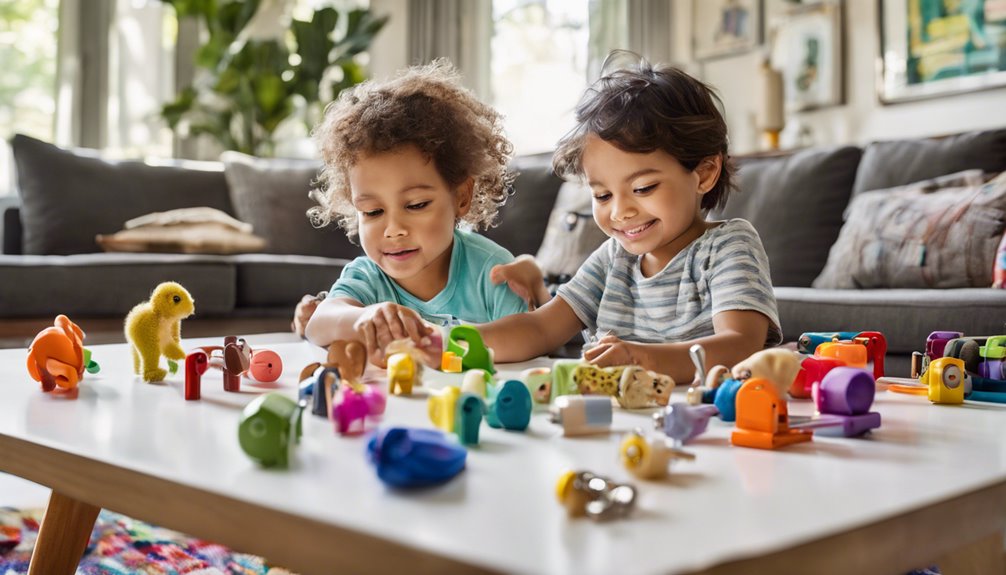
Verifying child safety locks function properly is just the beginning of safeguarding your home. To empower your parenting journey, leverage a variety of resources that enhance your safety education. Many organizations and websites provide crucial information, practical tips, and product recommendations designed for proactive parents like you.
Here’s a quick reference table highlighting essential parenting resources:
| Resource Type | Purpose |
|---|---|
| Online Articles | Offer insights and latest safety products |
| Parenting Forums | Facilitate community support and advice |
| Safety Workshops | Provide hands-on education and demonstrations |
| Government Guidelines | Inform about safety regulations and standards |
| Product Reviews | Help choose the best child safety locks |
Utilizing these parenting resources will refine your knowledge and verify you’re making informed decisions. Remember, safety is a continuous effort that goes beyond installation; regularly update your skills and knowledge. Equip yourself with essential resources to not only protect your child but to also create a safer environment. You’re in control; take charge of your child’s safety today!
Frequently Asked Questions
How Do I Know What Type of Lock I Need?
To determine the right lock type, consider what you need to secure.
Assess the safety features you want, like child resistance and durability.
For cabinets, adhesive or magnetic locks work well, while external cord locks are great for doors.
If you’re securing appliances, opt for specialized locks.
Make certain your choice allows for easy installation and fits the materials you’re working with.
Regular maintenance is key to guarantee they remain effective.
Can Child Safety Locks Be Removed Easily?
Yes, child safety locks can be removed easily, depending on their type.
For adhesive-backed locks, you’ll want to use a plastic scraper and a citrus-based remover for any residue.
Magnetic locks typically pull off gracefully without damage.
External locks require no tools and can be squeezed off.
For mechanical locks, use lubrication and follow manufacturer instructions.
Always prioritize safety measures during removal to prevent harming surfaces or locks, ensuring a smooth process.
Do Child Safety Locks Work on All Furniture?
Child safety locks don’t work on all furniture due to furniture compatibility issues.
Some locks aren’t designed for specific materials or designs, which can affect lock effectiveness.
It’s essential to check whether a lock suits the furniture type you’re securing.
Always opt for locks tailored to your furniture to guarantee they function properly, preventing access to dangerous areas and keeping your children safe.
Regularly inspect them to maintain their reliability.
Are There Any Eco-Friendly Lock Options Available?
You can find eco-friendly lock options that’ll make Mother Earth proud!
Look for products made from sustainable materials and those boasting green certification, ensuring they’re safe for your family and the planet.
Brands like The Honest Company and Bella Tunno lead the way, offering non-toxic, durable locks that even come with biodegradable parts.
How Do I Teach My Child About Safety Locks?
To teach your child about safety locks, start with practical teaching methods. Demonstrate how different locks work and emphasize safety awareness through engaging activities, like practicing locking and releasing doors.
Discuss household rules about doors and emergencies, empowering them with important skills. Make sure to incorporate regular practice sessions, reinforcing their understanding and confidence.
Conclusion
By investing in child safety locks, you’re building a sturdy fortress around your little explorer, keeping them safe from hidden dangers. Remember to choose the right lock, install it correctly, and routinely inspect its performance. Avoid common mistakes, and always stay informed about safety regulations. With these steps, you can guarantee a secure environment for your child, allowing them to roam freely while giving you peace of mind. Safety isn’t just a precaution; it’s a way of life.

